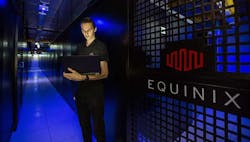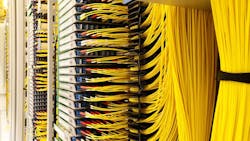Equinix NY5, NY11 Data Centers Generate Digital, Economic Magnetism from NY-NJ
SECAUCUS, N.J. – Digital infrastructure is the engine powering the Internet economy. And perhaps no company has come to embody this transformation more than Equinix, which has built a global network atop network intersections for data traffic.
“Digital (infrastructure) is the primary driver of economic growth and social progress that we see for the coming decade and beyond,” said Charles Meyers, the CEO of Equinix, in the company’s recent Investor Day. ”Equinix continues to be critical nexus for digital transformation around the world.”
The company has built a platform of 248 data centers across 70 countries, where it provides colocation services and more than 452,000 interconnections between customers. Most of these are physical interconnections – a network cable connecting to a port – but a growing number are virtual.
That’s a trend that reflects the evolution of Equinix, and the company’s vision for a future powered by on-demand services.
The foundation of that vision is an ecosystem that lives inside the company’s data centers, connecting customers to one another. As enterprise companies embrace hybrid cloud architectures, these connected ecosystems have strategic value.
A Financial Hub Grows in Secaucus
Digital transformation is a shiny, high-tech concept that sometimes happens in surprising places. Take Secaucus, a town nestled along the swampy expanses of the Meadowlands, intersected by the New Jersey Turnpike and Northeast Corridor rail line.
The industrial section of Secaucus may not seem sexy or futuristic, but it has become the digital center of gravity for global financial markets. A key linchpin is the Equinix NY5 data center, which houses many of the matching engines that drive electronic trading at the world’s leading stock exchanges.
“NY5 is very important to the capital markets,” said Bill Ruvo, who heads business development for the financial services sector at Equinix. “The number of participants in the ecosystem continues to grow.”
NY5 is one of 9 Equinix data centers in Northern New Jersey and New York that provide 739,000 square feet of technical space for IT operations. That includes five sites in Secaucus and individual data centers in Jersey City, Carteret and at 111 8th Avenue in Manhattan.
NY5 and the Secaucus campus provide one of the best examples of a high-value connected ecosystem. The key organizing principle for digital ecosystems at Equinix is “magnetism” – businesses that will attract other customers, creating a virtuous cycle in which every interconnection boosts the value of the venue.
“One of the best outcomes for us is getting the right customers,” said Tiffany Osias, Vice President, Global Colocation Services for Equinix. “We have a very sophisticated customer targeting strategy. We want them to extract the maximum value possible, while contributing the maximum value possible.”
Perhaps no business fits that criteria better than financial trading. The Equinix Secaucus campus is among a handful of data centers in Northern New Jersey that manage electronic trading for the U.S. financial markets.
Other key hubs include Digital Realty facilities in Weehawken and Clifton, and the NYSE data center in Mahwah.
With the rise of algorithmic high-frequency trading strategies, financial trades are more likely to be managed by servers in these data centers instead of human market makers wearing colored smocks on exchange floors.
Having access to the financial firms and their matching engines – the hardware and software systems that manage trades – has value. These sites are a short fiber run from Wall Street, but offer vastly more colocation space than could be found in lower Manhattan.
NY5 was built in 2012 and expanded in 2016, and supports 20 megawatts of critical power capacity. It is engineered for continuous uptime, with N+1 power and cooling infrastructure, supported by four utility feeder lines, a bank of 8 2.5-megawatt backup generators, and redundant 185,000-gallon water tanks to provide backup water supply.
The facility has been battle-tested. In 2012, the Secaucus campus remained online for a week without grid power after Superstorm Sandy devastated New York and New Jersey.
Although exchanges and trading firms value physical proximity, they are also looking to leverage cloud computing to extend their reach and efficiency.
The Cloud Meets the Exchange
That trend can be seen about 20 miles to the south at the Equinix NY11 data center in Carteret, N.J. where the Nasdaq stock exchange is the primary customer. Equinix is expanding the facility to house a Local Zone for Amazon Web Services, bringing the world’s largest cloud platform into the Nasdaq data center.
The solution addresses a challenge for security-conscious financial services firms, who have reservations about shifting workloads into cloud data centers. So instead, the AWS cloud is extending into Nasdaq’s core network to deliver ultra-low-latency edge compute capabilities. Nasdaq plans to migrate its North American markets to AWS in a phased approach, starting with Nasdaq MRX, a U.S. options market.
“Using the capabilities of AWS Outposts, we can now bring the edge directly into our primary data center in Carteret, New Jersey, creating the first ever capital markets Private Local Zone,” said Adena Friedman, President and CEO of Nasdaq. “Together, we will create a cloud center inside the Nasdaq footprint, which allows us to transition our U.S. markets into the cloud.”
As enterprises look to the cloud, Equinix is becoming more cloud-like by adding services that allow customers to leverage virtualization. These include:
- Equinix Fabric - A software-defined networking solution that allows companies to connect to a broad universe of partners through a single network port.
- Equinix Metal - A bare metal server that brings cloud-style automation to physical infrastructure, enabling dedicated servers to be provisioned as a service.
- Network Edge - An enterprise service providing access to the Equinix SDN fabric and virtual network functions (VNFs) to manage and extend their network infrastructure.
Programmability is a key innovation theme at Equinix, especially the ability to “make business composable” by orchestrating services through APIs (application programming interfaces).
Osias said these on-demand services are growing at a 44% annual rate, about triple the growth rate of Equinix’s broader colocation business.
Equinix is also offering cloud-style provisioning with its Secure Cabinet Express initiative, which makes common cabinet configurations available for online ordering, pre-wired to the Equinix Fabric and ready for customer equipment.
“We have trimmed our (delivery timeline) from months into minutes,” said Bill Strong, Senior VP of IBX Operations at Equinix. Strong said that with the wide availability of cloud ordering, faster provisioning “is just the way the industry is going.”
Equinix sees business becoming more digital every day. The company’s Global Interconnection Index research finds that half of companies are already generating 40% of their revenue from digital products and services, and predicts that by 2025, 90% of the Fortune 500 will become “digital providers” that both sell and consume online services.
A Bigger, Denser Future
That digital future will require more data center space. On the Secaucus campus, Equinix is under construction on NY3, a 300,000 square foot data center that will deliver a first phase supporting 1,200 colocation cabinets for customer equipment.
As we’ve frequently noted here at DCF, the rising adoption of artificial intelligence (AI) is bringing more powerful compute hardware into data centers.
“AI is certainly in the headlines,” said Osias. “We’ve had AI in our data centers for years, and have our own AI operations as well. What that means from an architectural perspective is that we will be seeing more high-performance compute (HPC), which tends to create denser deployments.”
That trend is built into the NY3 design. Across the Secaucus campus, rack density is about 5 kW per cabinet, but NY3 will be designed for an average density of 9 kW to 10 kW, with the ability to support higher densities in some areas.
“We’re trying to make our data centers more flexible and future proof,” said Strong.
About the Author




